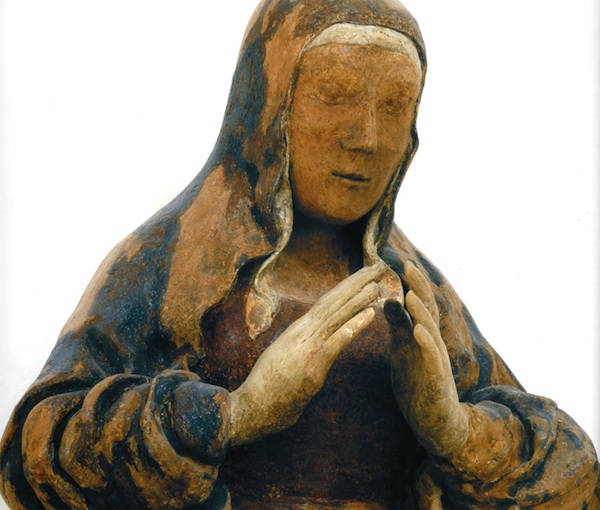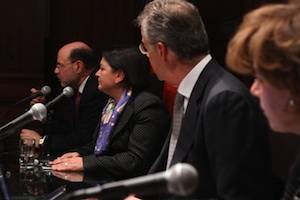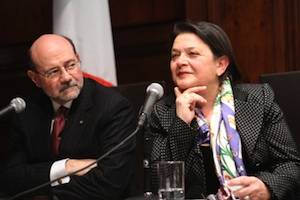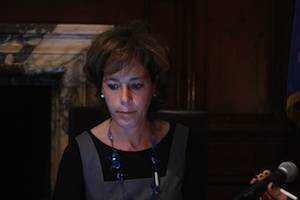Our Lady of Pietranico: The New Ambassador of The Cultural Heritage of Abruzzo Arrives to New York
p { margin-bottom: 0.08in; } p { margin-bottom: 0.08in; }On the second anniversary of the tragic Abruzzo earthquake, April the 6th, the Italian Culture Institute hosted a Press Conference on the restoration of “Our Lady of Pietranico” which is one of the most significant Abruzzo's artistic legacy. It is a precious sixteenth century terracotta Madonna which was shattered into 24 fragments and smaller pieces.
On the second anniversary of the tragic Abruzzo earthquake, April the 6th, the Italian Culture Institute hosted a Press Conference on the restoration of “Our Lady of Pietranico” which is one of the most significant artistic legacies of Abruzzo. It is a precious sixteenth century terracotta Madonna, whose author is uncertain, which was shattered into twenty-four fragments and smaller pieces.
In his welcoming greetings, the Director of the Institute, Mr. Riccardo Viale, explained how the fundraising made by the Italian American Museum is at the same time a strong collaboration between Italy and USA and a good example of fund-raising for Italian cultural heritage.
A fund-raising that, in Consul Talò’s words, is not a simple act of generosity but reveals a great sense of national unity. He added “ The Italian-Americans were the first to arrive to our Ministry, their donation was the most efficient and showed the chance to work together for common cultural values. Although it is impossible to reconstruct over two years, Italy has learned to face these problem. Of course there remains a lot to do”. He recognizes the role of the Italian experts in the restorations: “ To preserve the artistic heritage is fundamental. This is the best way to commemorate the victims. It is not just for the Italian identity, but for the economic values gained through tourism. Italy is a country of art, where art is studied and maintained. The Italian cultural heritage is universal”.
A documentary by Michele Bevilacqua was screened, focusing on the different steps of the one-year long job of restoration: the withdrawal of the sculpture on March the 17th 2010, the delivery to Rome, the assessment of the benchmark of restoration; the visit to Castelli, a small town in Abruzzo where a “ a respiro” oven was used to reproduce the lost hand. A big attention was given to the polichromy of the statue: 16 levels of previous restorations were found. Both mechanical means and 3D models were used. Support elements were added and the nose, two fingers and one hand were reconstructed .
The first guest speaker was Mario Resca, General Director of Italian Heritage and Antiquities, who said “We are bringing back to the Italian American Museum the witness of its generosity. After the earthquake there was a worldwide concern for a possible loss of the Italian heritage. Italy is a leading cultural heritage, it has cultural assets based on thousands years of history, so it has the responsibility to preserve, maintain, and share its culture.
Italy itself is a museum open-air. The recent 15 % increase of visits to our museums marks a growing interest for its historic heritage”.
Then the floor was given to Lucia Arbace, the Superintendent for the Historic and Artistic ethno-anthropological Heritage of the Abruzzo Region. She was really emotionally involved in her speech. Shattered in twenty-four fragments, the Madonna was exhibited during the G8 Summit in l’Aquila, so it became the new ambassador of the cultural heritage of Abruzzo. They had to reconstruct the lost hand to maintain the original iconography of the sculpture: the representation of the simple spiritualism of San Francis’s pray. Both this statue and the “Trittico di Beffi”, another painting restored after the earthquake, came to very small towns of Abruzzo. Beffi is a village with forty inhabitants and Pietranico counts 400 citizens.
Joseph Scelsa, President and Chief Executive Officer of the Italian American Museum, presented his institution with US $110,000 of funds to sustain the recovery and restoration of the Lady. The Museum was please to reclaim it, becoming incredibly a powerful connection among all Italian-Americans: people started coming to the museum from all around the US to make donations. He had no idea he would receive such an amount. “This is the sign of a collective activism. We are so sorry for the tragedy and very proud of this response” he said.
Finally Elisabetta Sonnino, chief of the restoration team, described the technical aspects of their job. She empathized how important was to do a document analysis of the previous restoration of the 1930's and field work in the village of Pietranico. This led them to analyze the social and community environments and the religious devotion to the statue, which are fundamental aspects to reveal the real symbolic value of a work of art.
Our Lady of Pietranico will be on view at the Italian-American Museum in Mulberry Street, in New York, until next June.





































i-Italy
Facebook
Google+
This work may not be reproduced, in whole or in part, without prior written permission.
Questo lavoro non può essere riprodotto, in tutto o in parte, senza permesso scritto.